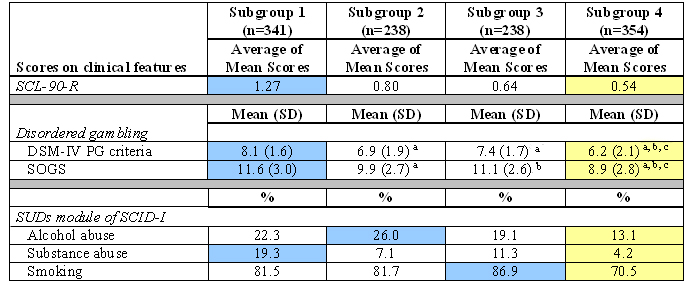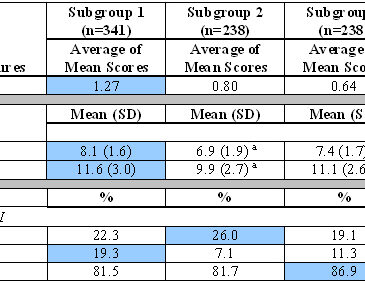Research indicates that pathological gambling (PG) is an expression of a common underlying addiction syndrome (Shaffer et al., 2004). Syndromes, by their definition, suggest people with the same expression of addiction are likely to exhibit predictable signs and symptoms, but those signs and symptoms vary and need not be present all the time. Such variability allows for the possibility of different PG subgroups that are more or less likely to share signs and symptoms. This week The WAGER discusses one possible set of subgroups and some associated clinical idiosyncrasies (Alvarez-Moya et al., 2010).
Methods
- Participants (n=1171; 74% response rate) were Caucasian PG treatment seekers from a University hospital in Spain.
- Of the 1576 recruited patients, 160 declined to participate, 148 met exclusion criteria for severe psychiatric disorders, and 97 had incomplete data.
- Participants completed the following:
- Personality assessment – The Temperament and Character Inventory – Revised (TCI-R) assessed seven personality factors (i.e., novelty seeking, harm avoidance, reward dependence, persistence, self-directedness, cooperativeness, and self-transcendence) and the Eysenck Impulsivity Scale 17 assessed rash impulsiveness and venturesomeness.
- Clinical features – The SOGS and DSM-IV PG criteria measured disordered gambling; the Symptom Checklist – 90 Items – Revised (SCL-90-R) measured somatization, obsessive-compulsive, interpersonal sensitivity, depression, anxiety, hostility, phobic anxiety, paranoid ideation, psychoticism and General Symptom Index; and the substance use disorder module of the Structured Clinical Interview for DSM-IV (SUDs module of SCID-I) measured alcohol and drug abuse and smoking tobacco rates.
- The researchers performed a cluster analysis on participants’ personality assessment scores to determine PG subgroups. The clinical assessment scores demonstrated features of each subgroup.
Results
- The personality assessment analysis identified four subgroups of PG treatment seekers.
- Subgroup 1 (n=341) was disorganized and emotionally unstable with the highest impulse and self transcendence scores and the lowest self-directedness and cooperativeness scores.
- Subgroup 2 (n=238) was schizoid (e.g., socially aloof and avoidant) with the highest harm avoidance score and lowest reward dependence, persistence, self-transcendence and venturesomeness scores.
- Subgroup 3 (n=238) was reward sensitive with the highest novelty seeking, reward dependence, persistence, and venturesomeness scores and the lowest harm avoidance score.
- Subgroup 4 (n=354) was high-functioning with the highest self-directedness and self-transcendence scores and the lowest novelty seeking and impulsiveness scores.
- Table 1 shows the assessed clinical features for each subgroup. Subgroups 1 and 4 had the highest and lowest scores for SCL-90-R and PG scores, respectively; and Subgroups 2 and 3 had scores that fell in between the highest and lowest values.
Table 1 – Clinical Features Scores (adapted from Alvarez-Moya, et al., 2010)

Please note – The highest value for each assessment has a blue background and the lowest has a yellow background; SD – Standard Deviation; a statistically significant in comparison to Subgroup 1, b statistically significant in comparison to Subgroup 2, c statistically significant in comparison to Subgroup 3.
Limitations
- Participants self-reported for the questionnaires used for the personality assessment and clinical features.
- All of the participants in this study were seeking treatment for PG and mainly gambled using slot machines. This might affect the generalizability of the results. In addition, it is unclear whether each of these participants met diagnostic criteria for PG; this concern, then, raises important questions about whether these subgroups represent participants who meet criteria for PG or participants seeking treatment for PG.
Discussion
This study identified four types of treatment seeking pathological gamblers with differing features. Specifically, pathological gamblers are a heterogeneous group, but some PG treatment seekers might be more similar to each other than to other PG treatment seekers. Accounting for gambling subgroups could affect and improve treatment decisions. Unfortunately, the Alvarez-Moya et al. methodology cannot establish whether these groups reflect aspects of PG or a variety of other disorders that overlap with PG.
-Tasha Chandler
What do you think? Please use the comment link below to provide feedback on this article.
References
Alvarez-Moya, E. M., Jimenez-Murcia, S., Aymami, M. N., Gomez-Pena, M., Granero, R., Santamaria, J., et al. (2010). Subtyping study of a pathological gamblers sample. The Canadian Journal of Psychiatry, 55(8), 498-506.
Shaffer, H. J., LaPlante, D. A., LaBrie, R. A., Kidman, R. C., Donato, A. N., & Stanton, M. V. (2004). Toward a syndrome model of addiction: Multiple expressions, common etiology. Harvard Review of Psychiatry, 12, 367-374.





caren December 29, 2010
Interesting, however I lived with a gambler for 5 years, he was typically Sub group 1 liked to smoke cannabis, hardly ever drank alcohol, pref. cannabis to cigarettes and was characterist of sub-group 2 (socially aloof and avoidant) had no friends gambled alone and mainly played the slot machines. Perhaps the drugs made him socially aloof and avoidant, Of course extremely secretive.